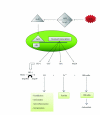Antioxidant and anti-inflammatory effects of exercise in diabetic patients
- PMID: 22007193
- PMCID: PMC3191828
- DOI: 10.1155/2012/941868
Antioxidant and anti-inflammatory effects of exercise in diabetic patients
Abstract
Diabetes is a chronic metabolic disease which is characterized by absolute or relative deficiencies in insulin secretion and/or insulin action. The key roles of oxidative stress and inflammation in the progression of vascular complications of this disease are well recognized. Accumulating epidemiologic evidence confirms that physical inactivity is an independent risk factor for insulin resistance and type II diabetes. This paper briefly reviews the pathophysiological pathways associated with oxidative stress and inflammation in diabetes mellitus and then discusses the impact of exercise on these systems. In this regard, we discuss exercise induced activation of cellular antioxidant systems through "nuclear factor erythroid 2-related factor." We also discuss anti-inflammatory myokines, which are produced and released by contracting muscle fibers. Antiapoptotic, anti-inflammatory and chaperon effects of exercise-induced heat shock proteins are also reviewed.
Figures


References
-
- Vassort G, Turan B. Protective role of antioxidants in diabetes-induced cardiac dysfunction. Cardiovascular Toxicology. 2010;10(2):73–86. - PubMed
-
- Ghosh S, Golbidi S, Werner I, Verchere BC, Laher I. Selecting exercise regimens and strains to modify obesity and diabetes in rodents: an overview. Clinical Science. 2010;119(2):57–74. - PubMed
-
- Zanuso S, Jimenez A, Pugliese G, Corigliano G, Balducci S. Exercise for the management of type 2 diabetes: a review of the evidence. Acta Diabetologica. 2010;47(1):15–22. - PubMed
-
- Zanuso S, Balducci S, Jimenez A. Physical activity, a key factor to quality of life in type 2 diabetic patients. Diabetes/Metabolism Research and Reviews. 2009;25(1):S24–S28. - PubMed
Publication types
MeSH terms
Substances
LinkOut - more resources
Full Text Sources
Medical
